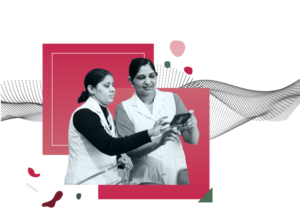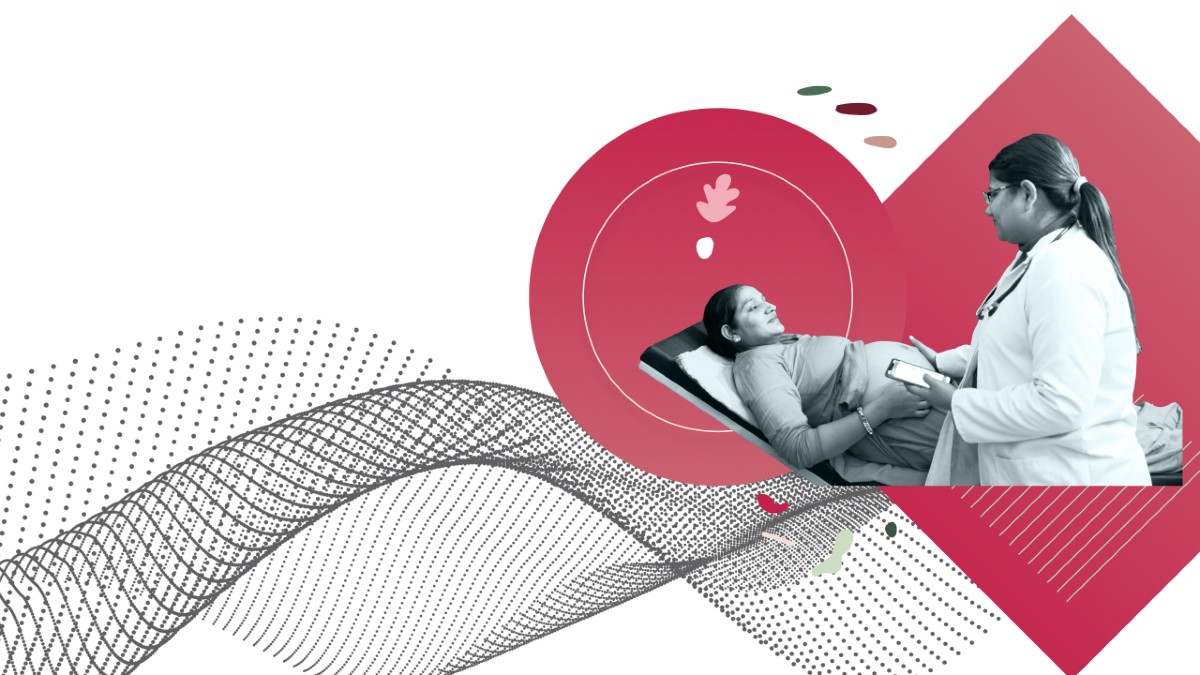Shaping the future of midwifery learning through data
How can we use data to analyze, predict and shape the future of midwifery training – and thus save more lives in childbirth? Maternity Foundation and benshi.ai are partnering to do just that.
This year’s theme for Day of the Midwife on May 5th is follow the data: invest in midwives. And with good reason. In the past years and months, a number of groundbreaking publications have come out using data to confirm what many of us already know – midwives save lives and are a smart investment for healthy, thriving mothers and babies.
Data can be used to better educate and support midwives, and to better target our investments in them. Not only can we use data to analyze our past and current approaches to training and learning – it can help us predict and shape the future and center it around the reality of the midwives on the ground.
Maternity Foundation and benshi.ai have teamed up to leverage data from six years of using the Safe Delivery App, Maternity Foundation’s digital training and learning tool for midwives and other health workers. These data are analyzed via benshi.ai’s world class machine learning platform (a combination of behavioral science and AI techniques).
So how does it work – and what does it mean for the midwives on the ground? Below are three examples of how we are using data to analyze the past, and to predict and shape the future of digital learning for midwives.
- Analyze the past:
Use analysis of historical data to assess whether efforts to reach midwives and other health care workers in areas with the greatest need have been successful.
In India, Maternity Foundation works with partners including Government of India (GoI), State Governments, UNICEF, and USAID – and with support from MSD for Mothers – to target areas of greatest need for improved quality of maternal and newborn health. To this end, the Government of India identified 115 “aspirational districts” as those most in need of support on health and other development areas. The Safe Delivery App was rolled out in trainings, projects, and programs in these districts as a learning tool, both on the job and in training. But did it take hold with midwives and other skilled birth attendants? Historical analysis of App data from benshi.ai suggests yes – both in terms of the number of users (see Figure 1) and in terms of their engagement (see Figure 2).
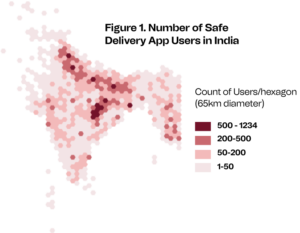
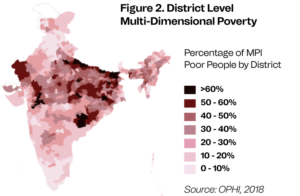
In short, our statistics in these two figures show that the aspirational districts – with the highest multi-dimensional poverty (acute deprivations in health, education, and living standards that a person faces simultaneously) and maternal mortality rates, and thus the biggest need for support – have the highest numbers of users and the most engaged users of the Safe Delivery App in the country. This demonstrates our success in reaching midwives and other health care workers with the greatest needs.
- Predict the future:
Based on performance to date, how will midwives perform in their online learning in the future?
Can past behavior help to predict future performance via machine learning? Data scientists at benshi.ai say yes – and are using historical data from midwives in Ethiopia to predict how well these same midwives will do in future online learning. In Figure 3, we see that among users who are predicted to progress in the Safe Delivery App’s self-directed learning component, MyLearning, the majority are midwives.In addition, we found that users who are predicted to progress beyond a key learning point in future are the same users who are forecast to use MyLearning for at least 100 minutes. Why does this matter? It suggests that we should continue to support and engage digitally savvy and driven midwives in Ethiopia (and beyond) to further build their learning competencies.
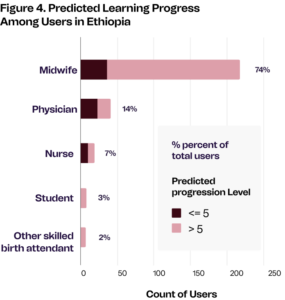
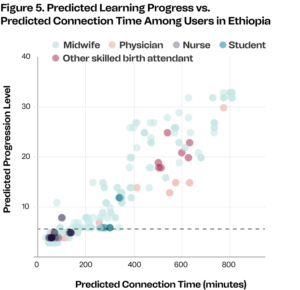
3. Experimentation to shape the future.
If we can predict when midwives might drop off the Safe Delivery App, can we figure out how to better engage them before this happens?
Our analyses also predicted when and in which stage of the app each midwife user would leave. The next step in the collaboration between benshi.ai and Maternity Foundation is to experiment with what incentive works best to keep midwives engaged on the Safe Delivery App, and ultimately serve them better.
Experimentation is crucial because is the only way to indicate causation, ie that the incentive causes an effect. For example, if our predictions show that a particular midwife has a high risk of disengaging in the next 30 days, we could introduce incentives to try changing the outcome. One way is to encourage him/her to check out new in-app content by sending a personalized push notification, delivered at the right time when the user is predicted to access the app. Experiments are then conducted to assess the incentives that work best for different user groups and context. Live analysis of the App usage will also allow us to track how each user is reacting to the change and to continually improve the Safe Delivery App. The beauty is that this only improves as time passes – the more midwives we engage in digital learning, the more data we have, and the more targeted our support, training and investment can be.
This year’s International Day of the Midwife is centered around ground-breaking new data that clearly points to midwives as the silver bullet to ending preventable maternal and newborn deaths. Data from the Safe Delivery App, together with benshi.ai’s application of behavioral machine learning, unlocks greater understanding of how midwives use and engage with digital learning. As we invest in supporting and educating midwives, data is a key to do it better.
Both benshi.ai and Maternity are supported by the Bill & Melinda Gates Foundation, and Maternity Foundation is also supported by Merck for Mothers.
